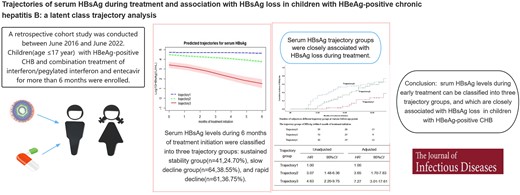-
Views
-
Cite
Cite
Zhenzhen Yao, Yingping Gu, Xin Lai, Meng Yang, Yi Xu, Jiayou Luo, Songxu Peng, Trajectories of Serum Hepatitis B Surface antigen (HBsAg) During Treatment and Association With HBsAg Loss in Children With Hepatitis B e Antigen–Positive Chronic Hepatitis B: A Latent Class Trajectory Analysis, The Journal of Infectious Diseases, Volume 231, Issue 1, 15 January 2025, Pages 196–203, https://doi.org/10.1093/infdis/jiae349
Close - Share Icon Share
Abstract
Changes in serum hepatitis B surface antigen (HBsAg) during treatment are associated with HBsAg loss. However, little is known about the trajectory patterns of HBsAg in early treatment and their relationship to subsequent HBsAg loss.
A retrospective study was conducted on 166 treatment-naive children with hepatitis B e antigen (HBeAg)–positive chronic hepatitis B (CHB). Latent class trajectory analysis was used to identify trajectory groups of serum HBsAg. Cox proportional hazards models were used to assess the association between HBsAg trajectory groups and HBsAg loss.
The median follow-up time was 20.70 (interquartile range, 12.54–34.17) months, and HBsAg loss occurred in 70 (42.17%) of all study participants. Using latent class trajectory analysis, HBeAg-positive patients with CHB were classified into 3 trajectory groups: trajectory 1 (sustained stability, 24.70%), trajectory 2 (slow decline, 38.55%), and trajectory 3 (rapid decline, 36.75%), respectively. The risk of achieving HBsAg loss was higher in both trajectory 2 (hazard ratio, 3.65 [95% confidence interval, 1.70–7.83]) and trajectory 3 (7.27 [3.01–17.61]), respectively.
Serum HBsAg levels during early treatment can be classified into distinct trajectory groups, which may serve as an additional predictive indicator for HBsAg loss in HBeAg-positive children with CHB.







